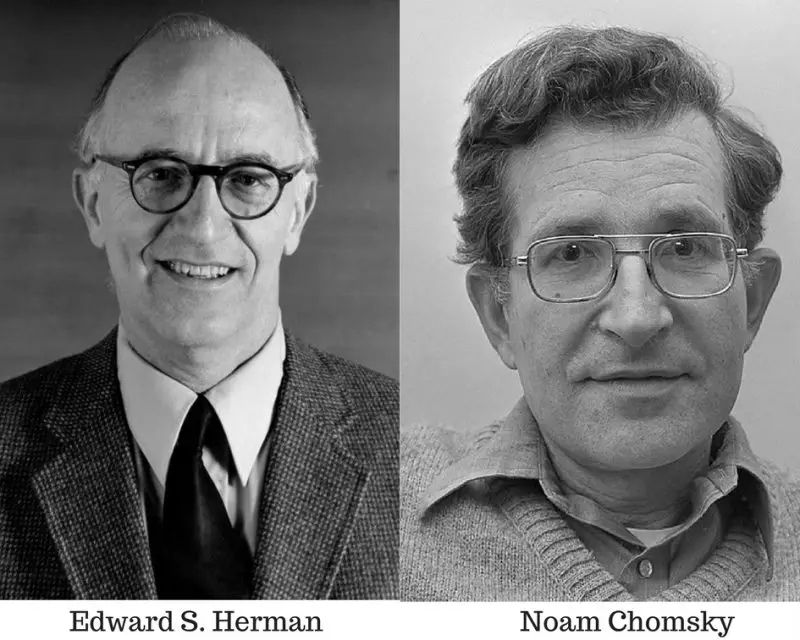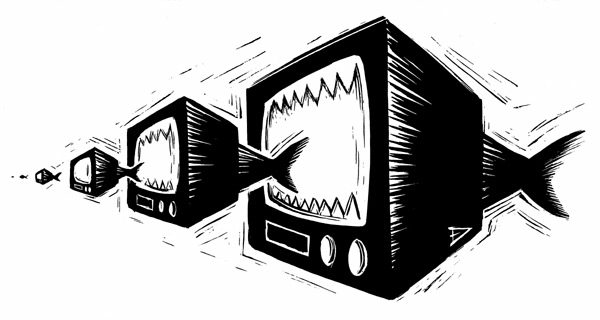Propaganda Model of Communication was developed to explain how propaganda, systematic biases, pressures, and constraints have been influencing mass media. The model explains how economic, social and political policies are manufactured in order to manipulate the populations for the welfare of those groups with power and money.
The founders of this model mostly concentrated on the population and media of the USA for the research but this theory is universally applicable.
History of Propaganda Model

Propaganda Model of Communication was first introduced in 1988 by the two Americans – philosopher Avram “Noam” Chomsky and late Edward Samuel Herman, who was a professor of emeritus of finance at the Wharton School of Business – through their book, Manufacturing Consent: The Political Economy of the Mass Media.
The ideas of this theory are derived from the works done by late Harold Lasswell on wartime propaganda during the 20s to the 40s, and by late Jacques Ellul on the sociological techniques of propaganda and the media during the 50s and 60s.
Propaganda Model Theory
As written in their book by Chomsky and Herman, “A propaganda model focuses on this inequality of wealth and power and its multilevel effects on mass-media interests and choices. It traces the routes by which money and power are able to filter out the news fit to print, marginalize dissent, and allow the government and dominant private interests to get their messages across the public.”
This theory views media as a business which sells its products (the audience, readers, and subscribers) to other businesses that do their advertisements in the media, rather than disseminating news for the public. The theorists state that a news is passed through five filters before it reaches the audience. The filters make the news different from its original form by determining what events are newsworthy, how these events are to be covered and how much coverage they receive.
These five filters are:
- Size, ownership and profit orientation of mass media
- Funding
- Source
- Flaks
- Anti-communism
Size, ownership and profit orientation of mass media

The major news distributors are a part of large corporations and conglomerates. As a result, the information provided to the public largely depends upon the interests of these organizations, which in turn has a direct impact on the quality of the news.
For example: A fictional news channel, say World News, is owned by the World Entertainment Group, a subsidiary of Century World. World News is unlikely to publish any news which may endanger the benefit of its owners (both World Entertainment Group and Century World).
Funding
According to Chomsky and Herman, advertising is the primary source of income for the mass media. The media would have to bear heavier costs of operation and production if the advertisers weren’t there to fund them. Thus, it is needless to say that the media would filter the news in favor of their fund providers often for the sake of their existence.
For example: A corporate organization may threaten the mass media to withdraw their sponsorship contracts if the media publishes any content that may damage the reputation of the organization. It is therefore against the interest of the media to produce such news which is contrary to the beliefs of their sponsors.
Source
The cost of posting journalists everywhere would be excessively high for the mass media. So, they often rely on press releases and other public relation products for news which have already been tailored for publishing.
In addition, they also rely on concentrating their personnel (reporters and camera persons) where news stories are likely to occur, such as at the government-sponsored press forums. At such places, the media are provided with canned pieces of news which can save a lot of money and time of the media.
For example: The government officials and politicians are viewed as credible sources of information, the media avoid the need for fact-checking as it is both costly and time-consuming. The media also acts in favor of the sources ensuring that the source is delighted by fine-tuning of the news as they expect the continuous flow of news from them.
Flaks

A Flak is defined as a negative response from the audience to the programs or outlets broadcasted or published by the media. A flak can be of various types such as a lawsuit, complaints, government sanctions or petition.
Flaks on a large scale is destructive to the media. So, the media always have an eye for the negative responses. The fear for flaks forces the media to thoroughly look on the material and filter the information, especially before publishing news about public figures with huge fandoms in an attempt to avoid such stories which may bring negative responses to the media.
For example: Most of the mass media avoid publishing news which projects a negative image of religious leaders until and unless they have a strong evidence in order to protect the media’s reputation among the public.
Firing on-air personnel for expressing opinions which are viewed as controversial or not favoring the media giants also explains how the mass media try to avoid flak.
Anti-communism and fear
Chomsky and Herman have labeled anti-communism as a national religion and control mechanism. This filter mobilizes the population against a common enemy while portraying the opponents as insufficiently patriotic or in alliance with the enemy.
For example: Many American corporations and elite groups considered that the communism was an evil as it took their wealth and power from them and threatened their status. These elites who are also the owner of the mass media have adopted a policy to censor the articles and news which reflects the positive sides of communism.
Updates to the model
Chomsky and Herman republished their work in 2002 with minor updates to the model. The updates were based on the case studies related to three major factors.
- The dramatic centralization of the mass media that took place in the 90s.
- The increased globalization due to the rise of the internet.
- The deregulation and reduction of budgetary pressure to support non-commercial media.
Criticisms of Propaganda Model
There have been a few criticisms for this model. Given below are some popular ones.
- In 2004, Eli Lehrer wrote in his book, The Anti-Chomsky Reader, that the media is not a monolithic entity. He believes that the media is not bias because there are pieces of evidence when it has reported on and exposed cases of corporate corruption.
- Another critic of this theory is Walter LaFeber. Writing for The New York Times, the historian criticized Chomsky and Herman’s book (Manufacturing Consent). He stated that the model does not adequately explain how a powerful propaganda system would let military aid to the Contra rebels be blocked.
